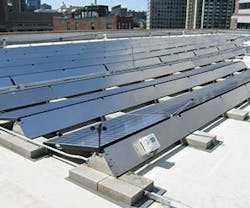Advances for Solar Hot Water and Window Films
Are you looking for new solutions to squeeze efficiency for your facility?
GSA’s Green Proving Ground (GPG) program allows the agency to test emerging technologies at federal buildings to overcome barriers to adoption. These trial sites shield commercial properties from having to take on the risk of new solutions and yield evidence-based data that will accelerate a product’s energy performance.
Two of the latest evaluations look at technologies that productively harness the sun’s power.
Photovoltaic-Thermal (PV-T) Hybrid Solar Systems: In order to convert solar radiation into electricity, standard photovoltaic systems need plentiful sunlight but shed excess heat in warmer climates. Photovoltaic-thermal (PV-T) hybrid solar systems address this problem by using a solar-thermal collector to capture that wasted heat in a way that is useful for heating domestic water.
GPG commissioned NREL to assess the performance of the nation’s first large-scale PV-T system installed at the Thomas P. O’Neill, Jr. Federal Building in Boston, MA in 2011. The evaluation found numerous lessons in system design, as well as operational best practices and deployment recommendations.
Modeling found that PV-T should target buildings in locations with high utility costs and electric hot water backup, such as Hawaii.
Applied Solar-Control Retrofit Films: Heat gain through windows accounts for 30% of cooling energy demand in U.S. commercial buildings. Applied solar-control films can reduce that demand by reflecting or absorbing solar energy before it reaches interior spaces.
GPG commissioned Lawrence Berkeley National Laboratories to assess the performance of a liquid-applied, spectrally selective absorbing film at the Goodfellow Federal Center in St. Louis, MO in 2012. Using collected results, LBNL modeled the energy performance of both spectrally selective absorbing and reflective films in a range of climates and found potential combined heating and cooling savings of up to 29% with reflective films.
